The Economics and Statistics Division maintains archives of previous publications for accountability purposes, but makes no updates to keep these documents current with the latest data revisions from Statistics Canada. As a result, information in older documents may not be accurate. Please exercise caution when referring to older documents. For the latest information and historical data, please contact the individual listed to the right.
<--- Return to Archive
For additional information relating to this article, please contact:
November 18, 2020ANALYSIS OF NOVA SCOTIA'S CONSUMER PRICE INDEX FOR OCTOBER 2020 TRENDS – OCTOBER 2020
Nova Scotia’s All-Items Consumer Price Index (CPI) increased 0.3 per cent year-over-year in October 2020. At the national level, consumer prices were up 0.7 per cent from a year earlier. Compared to September 2020, monthly consumer prices increased 0.7 per cent in Nova Scotia and 0.4 per cent in Canada.
On a year-over-year basis, national CPI growth increased from 0.5 per cent in September to 0.7 per cent in October. This was mostly due to higher prices for food which increased 2.3 per cent in October. Prices increased in five of the eight major components on a year-over-year basis. Clothing and footwear prices declined 4.0 per cent in October following a 4.1 per cent decline in September. Transportation and recreation, education and reading prices were lower compared to October 2019.
Mortgage interest costs were down 0.7 per cent month-over-month in October, following a 0.5 per cent decline in September. The increase in the rate of decline was mostly due to continued downward pressure from the Bank of Canada’s lower interest rates. Reflecting higher demand for single-family homes and lower interest rates, the homeowners’ replacement cost index increased 1.4 per cent month-over-month in October, posting the largest monthly gain since June 1991.
Impact of COVID-19 on the Consumer Price Index
Statistics Canada continued special CPI program measures for October 2020. Due to COVID-19 impact on product availability, select sub-components of the CPI received temporary special imputations. The sub-indexes for travel tours, components of spectator entertainment, recreational services, and some components of use of recreational facilities and services in some areas were imputed from the monthly change in the all-items index - effectively removing the impact of these goods and services on the CPI. Air transportation that was purchased but cancelled is excluded from calculations. Additional details can be found in the technical supplement.
Prices increased in all provinces on a year-over-year basis in October with Alberta posting the largest increase at 1.1 per cent. The lowest annual increases were recorded in Manitoba, New Brunswick and Prince Edward Island, all posting a 0.1 per cent annual gain in October.
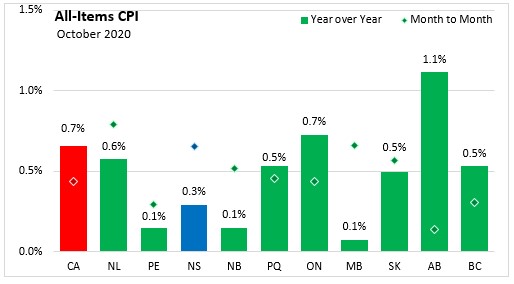
- The main contributors to the monthly (October 2020 vs. September 20200 in Nova Scotia CPI were:
- Purchase and leasing of passenger vehicles (+1.4%)
- Rent (+0.8%)
- Homeowners’ replacement cost (+1.1%)
- Traveller Accommodation (-7.8%)
- Sugar and confectionary (-5.5%)
- Processed meat (-2.9%)
Nova Scotia's consumer price inflation (year-over-year growth in CPI) excluding food and energy was 1.5 per cent in October. All provinces reported year-over-year increases with the national rate at 0.8 per cent. Prince Edward Island (+1.6%) and Newfoundland and Labrador (+1.6%) reported the largest price level increases, while Manitoba (+0.4%) reported the smallest increases.
Compared to the previous month, the CPI excluding food and energy was up in all provinces.
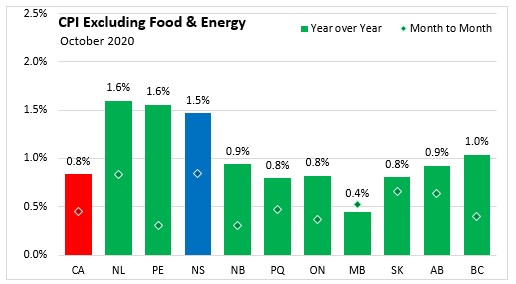
The CPI for food in Nova Scotia increased 1.9 per cent year-over-year in October, faster than 1.2 per cent increase last month. Year-over-year, food prices increased in all provinces with the national average at 2.3 per cent. The largest annual gain was recorded in Prince Edward Island (+3.5%) while Saskatchewan posted the smallest increase at 1.1 per cent.
Compared to last month, food prices increased in all provinces. Food prices were up 0.5 per cent in Canada and 0.1 per cent in Nova Scotia compared to a month ago.
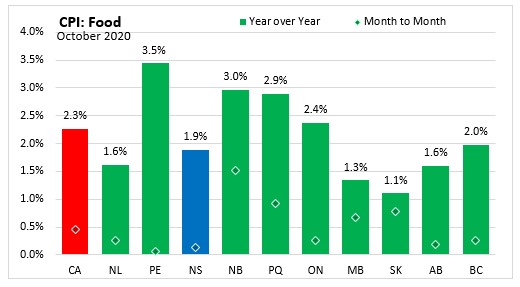
In October, the Nova Scotia energy price index decreased 12.2 per cent compared to a year ago. Year-over-year, the energy price index decreased in every province except Alberta, with a national average decline of 6.0 per cent. The largest annual decline was in Prince Edward Island (-14.6%).
Monthly energy prices (October 2020 vs. September 2020) were down in five of ten provinces, with the largest decline in Alberta (-4.5%) and Manitoba increasing 2.4 per cent. Energy prices were down in Nova Scotia by 0.1 per cent compared to September.
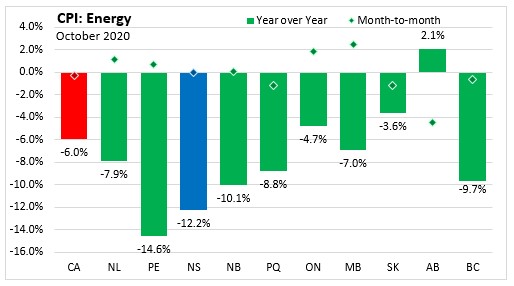
Year-over-year, Nova Scotia had the second largest decline in the consumer price index for shelter in October, with a decline of 0.5 per cent. This was just behind the 2.0 per cent decline registered in Prince Edward Island. For all of Canada, the shelter price index increased 1.8 per cent, with the largest increase in Ontario (+2.6%) and British Columbia (+2.2%).
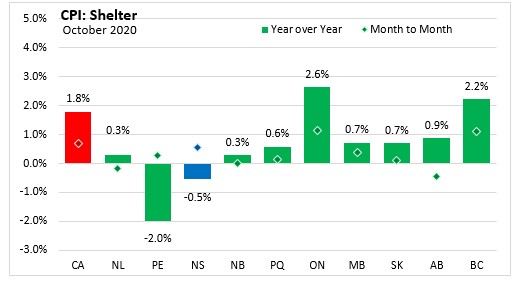
Nova Scotia's consumer price inflation (year-over-year growth in CPI) excluding energy was 1.6 per cent in October compared to a national rate of 1.1 per cent. The largest annual increase was posted in Prince Edward Island (+1.95) while Manitoba registered the lowest annual gain at 0.6 per cent.

Major Components for October 2020
The following table shows the price increases specific to Nova Scotia for the major components of the CPI this month:
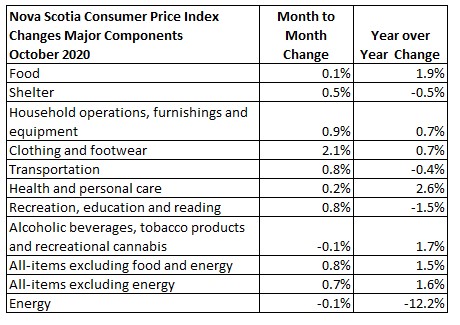
Long Run Trends
In October 2020, the All-Items CPI year-over-year inflation rate for Nova Scotia was 0.3 per cent, below Canada's average at 0.7 per cent. Nova Scotia's annual inflation has mostly been below the Canadian average since mid-2014, with the exception of only a few months. While month-to-month movements in the indices can be different, over time they generally follow the same overall trend. Nova Scotia’s year-over-year CPI inflation is currently at levels not seen since 2009.

Annual inflation for the CPI excluding food and energy in Nova Scotia (+1.5%) was higher than the national rate (+0.8%) in October 2020.
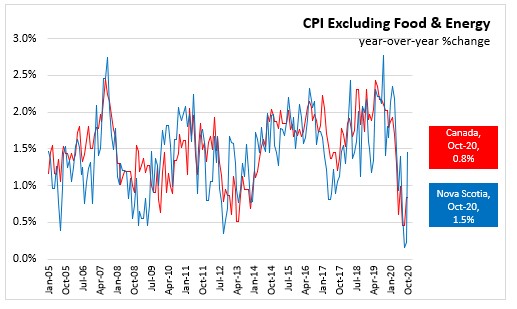
Bank of Canada's preferred measures of core inflation
Compared to October 2019, CPI-Common increased 1.6 per cent, CPI-Median rose 1.8 per cent and CPI-Trim was up 1.0 per cent in Canada. All-items CPI excluding eight of the most volatile components as defined by the Bank of Canada and excluding the effect of changes in indirect taxes (formerly referred to as CPIX), rose 1.0 per cent, year-over-year.
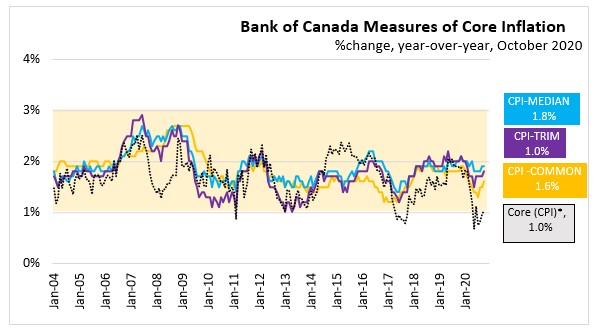
Appendix Tables and Charts

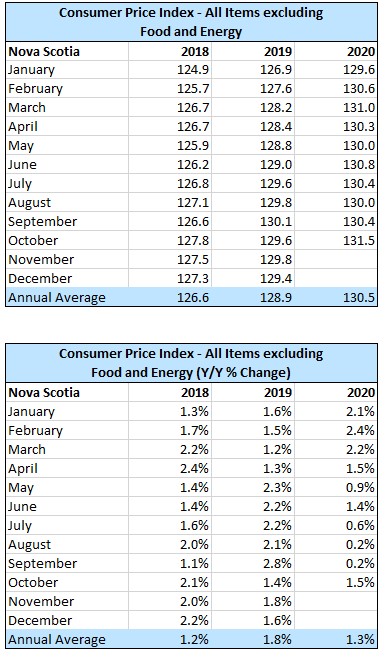
Source: Statistics Canada data portal: Tables 18-10-0004-01 and 18-10-0256-01
<--- Return to Archive